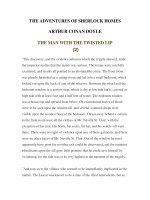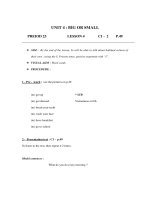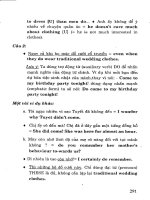4 6 2 a shifting society
Bạn đang xem bản rút gọn của tài liệu. Xem và tải ngay bản đầy đủ của tài liệu tại đây (5.09 MB, 14 trang )
Suggested levels for Guided Reading, DRA,™
Lexile,® and Reading Recovery™ are provided
in the Pearson Scott Foresman Leveling Guide.
A Shifting Society
by Joshua Nissenbaum
illustrated by Ron Mahoney
Genre
Expository
nonfiction
Comprehension
Skills and Strategy
• Fact and Opinion
• Sequence
• Text Structure
Text Features
•
•
•
•
Charts
Map
Captions
Glossary
Scott Foresman Reading Street 4.6.2
ISBN 0-328-13491-0
ì<(sk$m)=bdejbf< +^-Ä-U-Ä-U
Reader Response
A Shifting Society
1. Reread page 3. Using a chart similar to the one
below, fill in two facts and two opinions from this
page.
Opinions
by Joshua Nissenbaum
Facts
illustrated by Ron
Mahoney
2. The author uses time-order to structure this
selection. Make a timeline of major dates in the
selection and their significance.
3. Use the words manual and endurance in a
sentence.
4. How does the chart on page 10 help you
understand the Civil War?
Editorial Offices: Glenview, Illinois • Parsippany, New Jersey • New York, New York
Sales Offices: Needham, Massachusetts • Duluth, Georgia • Glenview, Illinois
Coppell, Texas • Ontario, California • Mesa, Arizona
A New Home
Every effort has been made to secure permission and provide appropriate credit for
photographic material. The publisher deeply regrets any omission and pledges to
correct errors called to its attention in subsequent editions.
Unless otherwise acknowledged, all photographs are the property of Scott Foresman,
a division of Pearson Education.
At the start of the 1800s, the United States was a
very young country. Independence had been won from
the British only seventeen years earlier, and the country
was growing. Every year new people arrived from
foreign countries, bringing new languages, new cultures,
and new ideas to the United States.
New Americans have not all been treated equally
or fairly, however. In the early 1800s, some people
discriminated against others based on skin color or
where they were from. Some people did not believe in
treating people of differing ethnicities equally or fairly.
New immigrants arrived and people explored the
country. People had to decide how to treat immigrants,
enslaved people, and the Native Americans living on the
newly explored lands.
American society has always valued personal
freedom and equality, although in the 1800s it was often
a struggle to achieve them. This period of time and the
changes that occurred helped to shape the country.
Photo locators denoted as follows: Top (T), Center (C), Bottom (B), Left (L), Right (R),
Background (Bkgd)
Opener: Ron Mahoney; 1 Hunter Museum of American Art; 3 Library of Congress;
4 North Wind Picture Archives; 5 North Wind Picture Archives; 6 Ohio Historical
Society; 7 Ron Mahoney; 8 Art Resource, NY; 13 Ron Mahoney; 14 Ron Mahoney;
15 Corbis; 17 Ron Mahoney; 19 Deleware Art Museum, Wilmington, USA/Bridgeman
Art; 21 Library of Congress; 22 Corbis
ISBN: 0-328-13491-0
Copyright © Pearson Education, Inc.
All Rights Reserved. Printed in the United States of America. This publication is
protected by Copyright, and permission should be obtained from the publisher
prior to any prohibited reproduction, storage in a retrieval system, or transmission
in any form by any means, electronic, mechanical, photocopying, recording, or
likewise. For information regarding permission(s), write to: Permissions Department,
Scott Foresman, 1900 East Lake Avenue, Glenview, Illinois 60025.
2 3 4 5 6 7 8 9 10 V0G1 14 13 12 11 10 09 08 07 06 05
Immigrants coming to the new land
3
Europeans sailing to America
The United States Expands
Even before the late 1800s, the United States had
begun to grow and change. Between 1780 and 1820, the
number of states in the country increased from thirteen
to twenty-three. Between 1790 and 1820, the number of
people living in the country nearly tripled.
The economy of the United States grew as factories
were built in the North and tobacco and cotton
production increased in the South. People built railroads,
roads, and canals to transport people and goods.
Farming tobacco and cotton required manual labor,
and these industries relied heavily on enslaved people
to pick the crops. Enslaved people spent their whole
lives on plantations working the land with their hands.
Immigrant workers helped fill the factories of the North.
The immigrants may have been free, but they worked
in very tough conditions for very little pay.
4
Many new immigrants moved west in search
of better options. There they became farmers and
trappers. In order for the new settlements to survive,
everyone had to help out. This led many people in
western territories to appreciate one another. But those
living in the North and South still had very different
views on personal freedom and equality.
Around the world, slavery was beginning to be
seen as morally wrong. In 1807 the English declared
the slave trade illegal, though it would be many years
before the British Parliament officially ended the
practice of slavery.
However, Southern plantation owners in the United
States relied heavily on the labor of enslaved people.
Between 1820 and 1860, cotton production increased
seventeen times and the enslaved population increased
two-and-a-half times. By 1860 there were almost four
million enslaved people living in the South.
Enslaved people picking cotton
5
Other authors also began to write about freedom.
Many writings challenged people to resist unjust laws
instead of just accepting them.
These writers helped make people aware of the
issues that abolitionists fought for. The incredible
success of Uncle Tom’s Cabin showed that many people
wanted to learn about slavery and put an end to it.
Harriet Beecher Stowe
Enslaved people were the property of their owners.
Their whole lives were spent working, and they were
sold or traded as their owners saw fit. Owners saw
enslaved people as a valuable source of labor.
By the mid-1800s slavery was a central issue in the
politics of the United States. People who wanted to end
slavery were called abolitionists. Abolitionists wanted
slavery declared illegal everywhere.
In 1852 Harriet Beecher Stowe wrote a book called
Uncle Tom’s Cabin. It told the story of an enslaved man
and the horrible experiences of his life. This book sold
more than 1,500,000 copies around the world.
Uncle Tom’s Cabin made it easier to understand why it
was so important to end slavery—so that people would
not be treated poorly or unfairly. It gave abolitionists a
personal story to help them in their fight against slavery.
6
A family reading Uncle Tom’s
Cabin together
7
The Civil War: 1861–1865
In 1860 Abraham Lincoln was elected President of
a country that was deeply divided. The South resented
his presidency and was worried that he would try to
end slavery. Seven Southern states decided to break
away and form their own country between December
1860 and February 1861. Four more states joined in
April 1861.
Alabama, Florida, Georgia, Louisiana, Mississippi,
South Carolina, Texas, Virginia, Arkansas, North
Carolina, and Tennessee formed a group called the
Confederate States of America. They elected their own
president. They even made their own constitution,
which allowed slavery to continue. This secession, or
withdrawal, was illegal, and it led to the Civil War.
The South felt strongly that they would win the
Civil War. Cotton, produced in the South, was the
largest exported good in the United States. In 1860 the
South sold more than $120,000,000 worth of cotton to
the world. The Southerners felt that the English and
French would help them win the war because they
wanted Southern cotton.
Abraham Lincoln
8
9
The South may have had a strong cotton economy,
but the North had more and better resources. The
North, or the Union, was larger and had more people.
There were more factories to make goods for the Union
army. There were many more miles of railroad to
transport the goods.
The Civil War officially began on April 12, 1861.
Both sides thought it would be over in months, but the
war took four years. Some of the leaders had military
experience, but most of the men were untrained as
soldiers at the start.
The North vs. The South
North (Union)
South (Confederacy)
Number of States
23
11
Population
22,000,000
5,100,000 whites
3,900,000 enslaved people
Economy
100,000 factories
20,000 factories
Railroad
20,000 miles
9,000 miles
Available Money
$50,000,000
$20,000,000
10
Lincoln issued the final version of the Emancipation
Proclamation on January 1, 1863. This freed all
enslaved people living in areas under Confederate
control. The war was now about both reunification and
ending slavery.
The Emancipation Proclamation also allowed exslaves to join the Union army. During the Civil War,
185,000 African American soldiers fought for the Union
army.
From July 1, 1863, to July 3, 1863, the armies of the
North and South fought the Battle of Gettysburg. This
was a major win for the Union army and a turning
point. On April 9, 1865, the leader of the Confederate
army, General Robert E. Lee, surrendered to the leader
of the Union army, General Ulysses S. Grant.
The end of the Civil War was a major event in the
history of the United States. The federal government
had successfully preserved the Union and ended
slavery. But this war was the bloodiest war fought in
American history. More than 600,000 American soldiers
had died, and huge areas of the country were destroyed.
11
The chart below describes the three amendments
that were added to the Constitution in order to protect
the rights of the formerly enslaved people. They
needed these amendments because even after the Civil
War, many people treated formerly enslaved people as
second-class citizens.
The Thirteenth, Fourteenth, and Fifteenth
Amendments were adopted to protect the rights of the
formerly enslaved people. Sadly, the government of
the United States could wage a war and officially end
slavery, but it could not force each person in the United
States to treat others with respect.
The Reconstruction Era followed the Civil War.
During this time, people rebuilt cities and farms, and
Southerners returned to their homes.
The newly freed people had a tough time during
Reconstruction. Much of the South did not recognize
their freedom, and their former masters made it very
difficult for them to find new work.
Some formerly enslaved people stayed with their
old masters as paid employees, while others left. Many
freed people looked for family members that they had
not seen in years.
After two hundred years of slavery in the United
States, Americans had to change the way they thought
about African Americans before African Americans
could be treated as equals. Changing society’s beliefs
about African Americans took time.
Amendments to the Constitution
The Thirteenth Amendment outlawed slavery in the United
States and any area under United States control. Threefourths of the states passed it on December 6, 1865.
The Fourteenth Amendment granted citizenship to
all people born in the United States. Newly freed
people of the South were also made citizens
with full rights. Passed by three-fourths of the
states on July 9, 1868.
The Fifteenth Amendment granted all male citizens
the right to vote. Passed by three-fourths of the states
on February 3, 1870.
Freed African Americans
12
13
Westward Expansion
During the late 1800s many immigrants entered the
United States from Europe and Asia. From 1850 to
1900, approximately 16,500,000 immigrants came into
the country. The majority arrived during the period
from 1880 to 1900. These people came to the United
States because it offered them more opportunities than
their home countries did.
In 1862 the Homestead Act became law. This gave
every American citizen the chance to own a farm. The
Homestead Act stated that in certain areas of the United
States, people could claim up to 160 acres of land. After
five years these people could own the land as long as
they built a home on the land and farmed part of it.
The Homestead Act encouraged settlement and
development of the West. Immigrants from all over
Europe came to the United States and immediately
claimed their own land.
Immigrants moved west and set up their own farms.
They traveled on trails that had been created years
earlier by explorers. One of the most famous trails was
the Oregon Trail.
In 1812 Robert Stuart became the first person to use
the route that became known as the Oregon Trail. He
traveled on a horse and carried his supplies with him.
His trail improved over the track that Lewis and Clark
had mapped out a few years before. The trail stretched
approximately two thousand miles and went through
Missouri, Kansas, Nebraska, Wyoming, Idaho, and
Oregon.
In 1836 Marcus Whitman and his wife Narcissa
almost completed the entire Oregon Trail in a wheeled
wagon. The Whitmans sparked more westward
advancement. Once settlers realized that they could
travel by wagon, they
were able to take all the
supplies that they needed
to set up permanent
homes in the West.
The Oregon Trail
14
15
In 1843 a wagon train of one thousand people set
out from Independence, Missouri, bound for Oregon.
Crossing the Rocky Mountains was a challenge to their
endurance, but the group managed to cross through a
pass known as the South Pass. This was the only place
between Missouri and Oregon gentle enough for wagon
travel. This journey became known as the “Great
Migration.”
By 1861 roughly 350,000 immigrants had traveled
west on the Oregon Trail. Even though the settlers
traveled in groups and followed trails, their journey
proved to be dangerous. Along the way they faced
tough weather and the possibility that their wagons
could break an axle or that their oxen could die.
Sometimes—although rarely—the Native Americans
who lived on the land through which the Oregon
Trail passed attacked the wagon trains. But most of
the people who died on the trail died from disease or
accidents.
In 1890 the results of the national census showed
that the frontier was closed. Throughout the West there
were new communities made up of mixtures of people
who had originally come from Sweden, Germany,
Ireland, and many other European countries—as well as
Central America, Asia, and Africa.
A wagon train leaving the Rocky Mountains
heading for the Oregon plains
16
17
Native Americans
The government may have given enslaved people
freedom, but it took away freedom from Native
Americans. Nations of Native Americans had lived
in every part of the United States for thousands of
years. They had developed complex cultures and
languages. However, their way of life differed from
white Americans. The government did not value the
Native American way of life and did not provide Native
Americans with any rights.
As immigrants came to the United States and settled
in “new” areas, they took land away from Native
Americans. The government forced Native Americans
off their land and paid very small sums of money for it.
Around 1812, a chief of the Shawnee nation named
Tecumseh tried to unite Native Americans. He hoped to
protect all Native American land from the Europeans.
He traveled from the Great Lakes to the Gulf of Mexico
and spoke with the different Native American groups.
Then the Indian Removal Act of 1830 allowed the
United States government to force Native Americans
from their land to “Indian Territory.” The land that is
now Oklahoma marked an area set up by the United
States government for Native Americans.
Tecumseh and the settlers
18
19
The Homestead Act of 1862 is a good example of
how the United States government placed the rights
of settlers before the rights of Native Americans. The
Homestead Act allowed settlers to claim ownership
over land that had been part of the “Indian Territory.”
Native Americans had lived on this land for thousands
of years, yet it was given away to the European settlers
when they settled the West.
In addition to taking the land of the Native
Americans, the government also tried to end their
culture. In 1883 the Indian Religious Crimes Code
punished Native Americans who continued to practice
their religion. Punishments included being sent to jail or
having the government withhold financial support.
The government passed this law to try to make
the Native Americans live like the rest of American
society. The government helped to set up boarding
schools throughout the country to teach Native
American children how to fit into American society.
While at boarding school, the children lived together
in a building called a dormitory. The teachers at these
schools allowed the children to speak only English and
did not teach them about their Native American cultures.
By the late 1800s the majority of Native Americans
lived on reservations or in boarding schools. Life
proved to be difficult for them. Shortages of both food
and good farming land made it impossible for Native
Americans to live as they had traditionally.
In 1926 the United States government wrote a
report that studied the conditions on Native American
reservations. This report criticized the reservation
system and stated that the United States government’s
effort to force Native Americans to adopt the American
way of life had been a total failure.
Native American schoolhouse
20
21
American Life in the 1800s
By 1899 the United States was a very different
country from what it had been in 1800. Throughout the
century more than nineteen million immigrants entered
the country. They came from Europe, Asia, Canada,
Latin America, and Africa. These immigrants greatly
influenced the development of the United States.
At the start of the 1800s the immigrants had worked
mainly agricultural jobs. As the cities grew, many went
there to work in the factories. The little chance of
advancement for these immigrants made life difficult for
them.
Events before and after the Civil War caused many
people to think more about personal freedom and
equality.
Following the Civil War even more immigrants
entered the country. The government welcomed these
people and encouraged them to settle in the West.
Wagon trains crossed the country and by 1890 the
government declared that the settlers had settled so
many places that there no longer were frontier areas.
During the 1800s America absorbed millions of
immigrants and became a true “melting pot.” By the end
of the 1800s America had grown to fill its borders and
had learned the importance of equality and personal
freedom.
Immigrants in the 1800s
22
23
Glossary
boarding schools n.
schools with buildings
where pupils live during
a school term.
dormitory n. a building
with many rooms in
which people sleep.
endurance n. power to
last and to withstand
hard wear.
Reader Response
manual adj. done with
the hands.
reservations n. lands
set aside by the
government for a
special purpose.
1. Reread page 3. Using a chart similar to the one
below, fill in two facts and two opinions from this
page.
Opinions
Facts
society n. the people of
any particular time or
place.
2. The author uses time-order to structure this
selection. Make a timeline of major dates in the
selection and their significance.
3. Use the words manual and endurance in a
sentence.
4. How does the chart on page 10 help you
understand the Civil War?
24









